Closing the Gap - Prime Minister’s Report 2015
© Commonwealth of Australia 2015
ISBN 978-1-925237-25-2 (Hardcopy) ISBN 978-1-925237-26-9 (PDF) ISBN 978-1-925237-27-6 (Word)
Ownership of intellectual property rights in this publicationUnless otherwise noted, copyright (and any other intellectual property rights, if any) in this publication is owned by the Commonwealth of Australia (referred to below as the Commonwealth).
Creative Commons licence
With the exception of the Coat of Arms, this publication is licensed under a Creative Commons Attribution 3.0 Australia Licence.
Creative Commons Attribution 3.0 Australia Licence is a standard form license agreement that allows you to copy, distribute, transmit and adapt this publication provided that you attribute the work. A summary of the licence terms is available from http://creativecommons.org/licenses/by/3.0/ au/deed.en. The full licence terms are available from http:// creativecommons.org/licenses/by/3.0/au/legalcode.
The Commonwealth’s preference is that you attribute this publication (and any material sourced from it) using the following wording:
Source: Licensed from the Commonwealth of Australia under a Creative Commons Attribution 3.0 Australia Licence.
The Commonwealth of Australia does not necessarily endorse the content of this publication.
Use of the Coat of Arms
The terms under which the Coat of Arms can be used are set out on the Department of the Prime Minister and Cabinet website (see http://www.dpmc.gov.au/guidelines/).
Please be aware that this report may contain images of Aboriginal and Torres Strait Islander people who have passed away.
Introduction
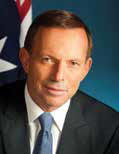
The Hon Tony Abbott MP Prime Minister of Australia making communities safer.
“It’s hard to be literate and numerate without attending school; it’s hard to
find work without a basic education; and it’s hard to live well without a job.”
I made this comment in the Australian Parliament one year ago. It goes a long
way to explaining why the Government has spent the past 12 months focusing
our efforts in Indigenous Affairs on getting children to school, adults into
jobs and making communities safer.
This is the seventh Closing the Gap Report produced since targets were set by
the Council of Australian Governments (COAG) in 2008. Despite good intention and
considerable investment by successive governments,
the disparity in outcomes remains.
Although there has been some improvement in education and health
outcomes for Indigenous Australians, in
many areas progress has been far too slow.
It is profoundly disappointing that most Closing the Gap targets are not on
track to be met.
The Government is now one year into its plan to address what have been
intractable issues around Indigenous disadvantage
and fundamentally change the way
Indigenous
policies and programmes are delivered.
Reducing the levels of red tape and administration is important,
but our main focus is on achieving
results.
Achieving results requires more than
just government effort. I acknowledge and thank the communities, private
sector and non-government sector for their work in
helping Aboriginal and Torres Strait Islander peoples achieve their full
potential to live a good life. Andrew Forrest was asked for his advice and has
highlighted a broad
range of issues in his independent review of employment and training.
The Government has received practical advice from the Indigenous Advisory
Council, chaired by Warren Mundine, on the three priority areas of getting
children
to school, adults into jobs and making communities safer which are fundamental
to improving the lives of Aboriginal and Torres Strait Islander individuals,
families
and communities. Focusing on these priorities will produce real progress against
the Closing the Gap targets and help to address the most intractable
difficulties in
eliminating Indigenous disadvantage.
The other key priority for the Government is to recognise Indigenous Australians
in the Constitution. A referendum should be held as soon as possible once we are
comfortable
that we have a proposal with the best chance of success. I hope that it might
happen on the 50th anniversary of the 1967 referendum, on 27 May 2017.
That would be a richly symbolic time to complete our Constitution.
The Hon Tony Abbott MP
Prime Minister of Australia
Overview of the Government’s priorities for Indigenous Affairs
This Government wants to work with Indigenous Australians and communities to make real improvements in their lives. We will do this while recognising the special place of Aboriginal and Torres Strait Islander peoples in our national story. The Commonwealth’s Indigenous Affairs agenda is aimed at building on previous work – but with a greater focus on areas that have been shown to improve outcomes for Aboriginal and Torres Strait Islander peoples. There are three priority areas that have been proven to have a positive effect on the lives of Aboriginal and Torres Strait Islander peoples:
• getting children to school to provide the best chance of enjoying success in school and later in life • getting adults into work to ensure Indigenous Australians participate in the modern economy • making Indigenous communities safer for people to live, work and raise their families.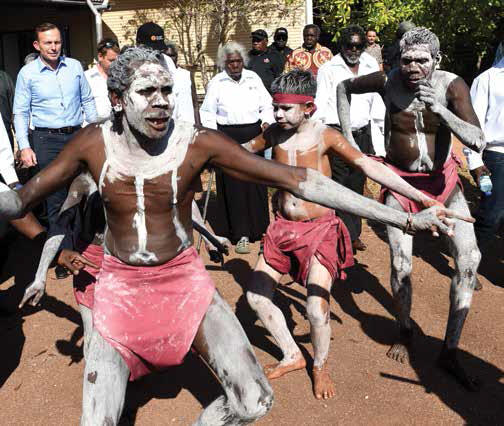
The Prime Minister is Welcomed to Country as part of his visit to the Buku-Larrnggay Mulka Art Centre in Yirrkala, Northern Territory. AAP image/Tracey Nearmy.2
Any work in these priority areas must be underpinned by improving the health and wellbeing of individuals, families and communities. That is why the Government is developing an Implementation Plan for the National Aboriginal and Torres Strait Islander Health Plan 2013
-23.The past year was one of developing practical reforms so we have a solid platform from which to deliver improvements. To this end, the Government has received advice from the Prime Minister’s Indigenous Advisory Council, chaired by Mr Warren Mundine, on practical ways to improve educational outcomes and school attendance, employment and economic development, and community safety.
The Prime Minister, along with senior ministers and government officials, spent almost a week in September 2014 running the Government from North East Arnhem Land. This visit was at the invitation of the highly respected Aboriginal and ceremonial leader of the Gumatj clan, Mr Galarrwuy Yunupingu AM. The visit provided a valuable opportunity for the Government to experience first-hand the challenges facing Aboriginal and Torres Strait Islander peoples living in remote communities while focusing the nation’s attention on important issues affecting Indigenous Australians.
This work has provided the foundation for the year ahead. This year will be one focused on action that will over time accelerate progress against the Closing the Gap targets, including the new target of closing the school attendance gap within five years.
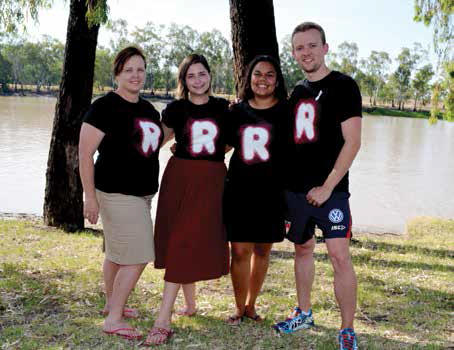
Recognise staff and volunteers on the Queensland leg of the Journey to Recognition.
Remote School Attendance Officers from Borroloola, Northern Territory with Bush TV film crew.
Closing the Gap targets
|
Progress against the targets Key findings: Target |
Target year |
Progress |
Results |
|
Close the gap in life expectancy within a generation |
2031 |
Not on track |
Limited progress. |
|
Halve the gap in mortality rates for Indigenous children under five within a decade |
2018 |
On track |
Long term progress. |
|
Ensure access for all Indigenous four-year-olds in remote communities to early childhood education |
2013 |
Not met |
In 2013, 85 per cent of Indigenous fouryearolds were enrolled compared --to the target of 95 per cent. |
|
Close the gap between Indigenous and non-Indigenous school attendance within five years |
2018 |
New target, baseline 2014. |
|
|
Halve the gap in reading, writing and numeracy achievements for Indigenous students |
2018 |
Not on track |
There has been no overall improvement in Indigenous reading and numeracy since 2008. |
|
Halve the gap for Indigenous Australians aged 20-24 in Year 12 attainment or equivalent attainment rates |
2020 |
On track |
The gap is narrowing in Year 12 or equivalent attainment. |
|
Halve the gap in employment outcomes between Indigenous and non Indigenous Australians - |
2018 |
Not on track |
There was a decline in employment outcomes since the 2008 baseline. |
Target
Close the life expectancy gap within a generation (by 2031) ‑ Limited progress
From 1998 to 2013, overall Indigenous death rates have declined significantly
(by 16 per cent) and there has been a significant decline in the gap (by 15 per
cent). However, no significant change was detected between the 2006 baseline and
2013, and rates are not on track to meet the target.
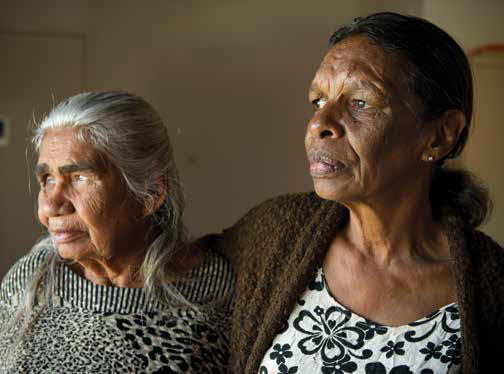
Edna Skeen and Julie Johnson at the young mums and bubs group, Halls Creek, Western Australia.
Figure 1 shows that
the current rate of progress will have to gather considerable pace if the target
is to be met by 2031.
The most recent life expectancy figures were published in late 2013 and featured
in last year’s report. In 2010–12, Indigenous life expectancy was estimated to
be 69.1 years for males and 73.7 years for females. The gap
in life expectancy between Indigenous and non-Indigenous Australians was 10.6
years for males and 9.5 years for females. Between 2005-07 and 2010-12, there
has been a small reduction in the gap of 0.8 years for males
and 0.1 years for females.
Life expectancy estimates for Aboriginal and Torres Strait Islander peoples are
only published every five years. Updated estimates are expected to be published
by the Australian Bureau of Statistics in 2018. In
the interim, overall death rates are used to assess progress in closing the gap.
Between 2008 and 2012, chronic disease (including circulatory disease, cancer,
diabetes, kidney and respiratory diseases) accounted for 70 per cent of
Indigenous deaths. Chronic disease also accounted for 81 per cent of the gap in
death rates between Indigenous and non-Indigenous Australians.
From 1998 to 2012, Indigenous death rates from chronic disease have declined
significantly (by 19 per cent) and there has been a significant decline in the
gap (by 14 per cent). However, since 2006 the gap widened for cancer mortality
and there has been no improvement for diabetes or external causes of death such
as suicide and transport accidents.
Improvements in life expectancy will be supported by real progress in education,
employment, housing, income, safety and preventing health risk behaviours.
Schooling ‑ Getting the most out of education
The education of Aboriginal and Torres Strait Islander children is
everybody’s business. Parents, carers, communities and governments must see
themselves as
partners in this crucial initiative. Improving education outcomes starts with
good early childhood development, effective parenting and strategies to ensure
kids are ready for school.
Going to school and being at school every day gives children the best start in
life.
Making that happen for Aboriginal and Torres Strait Islander children is one of
the Government’s top priorities.
A decent school education provides children with the opportunities for higher
education and employment; with flow‑on benefits for
health, social and emotional wellbeing and improved living standards.
We are committed to breaking the cycle of non‑attendance and ensuring parents
and carers take responsibility for educating their children.
We know that 20 per cent of the gap in school performance is attributed to poor
school attendance (Biddle 2014). In very remote parts of the Northern Territory
less
than a quarter of Indigenous students (23 per cent) attend school 80 per cent or
more of the time (Office of the Children’s Commissioner NT 2014).
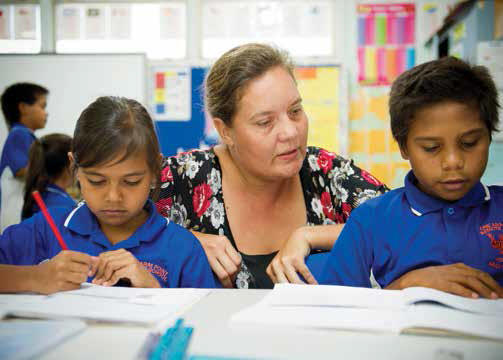
Joeisha Maher, Belinda Mallard and
Hakeem Davey at One Arm Point Remote Community School,
Ardyaloon Community, Dampier Peninsular, Western Australia.
Strengthening business opportunities and
communities
The Government will continue
to work with individuals, communities and businesses to build stronger
Indigenous organisations and find practical ways to foster economic prosperity
at the individual, family and community level.
All Australians should have the opportunity to own their own home and run
their own business. Increased access to safe, fair and affordable loans and
financial services can enable individuals to accumulate assets and increase
their economic mobility.
Greater flexibility in how Aboriginal and Torres Strait Islander peoples choose
to use the land they own and live on, can help to create stronger and more
independent futures for people living in communities on Indigenous land.
The Government continues to support Indigenous businesses, including through
Indigenous Business Australia (IBA) which provides new and existing Indigenous
business owners access to expert advice
and business finance. IBA is also increasing its focus on helping Indigenous
landowners to build wealth and maximise economic outcomes from their land and
native title rights. This includes new investment options for Indigenous groups
and developing Indigenous investment principles that meet international best
practice.
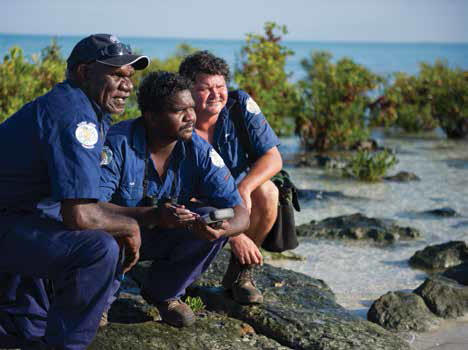
Bardi Jawi Rangers Christopher Sampi, Kevin Dougal and Mark Shadforth at
Ardyaloon Community, Dampier Peninsular, Western Australia.